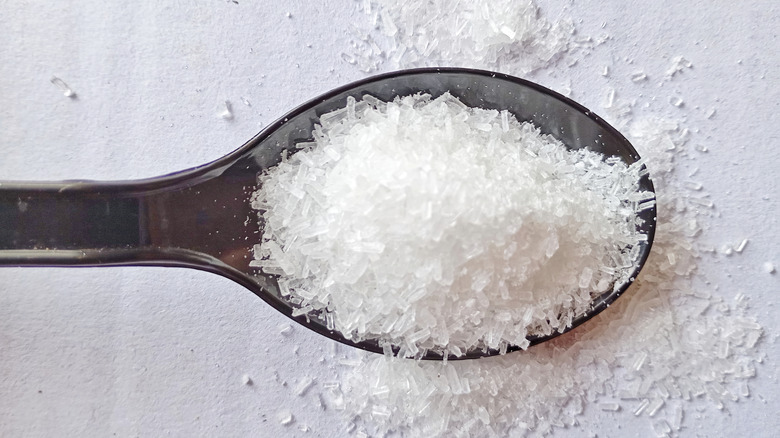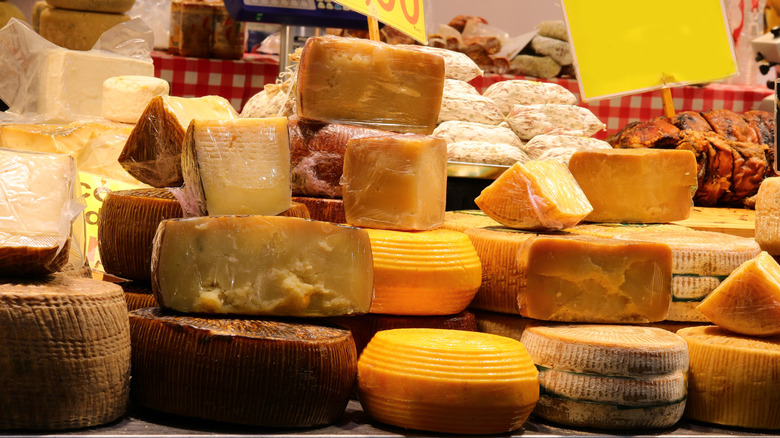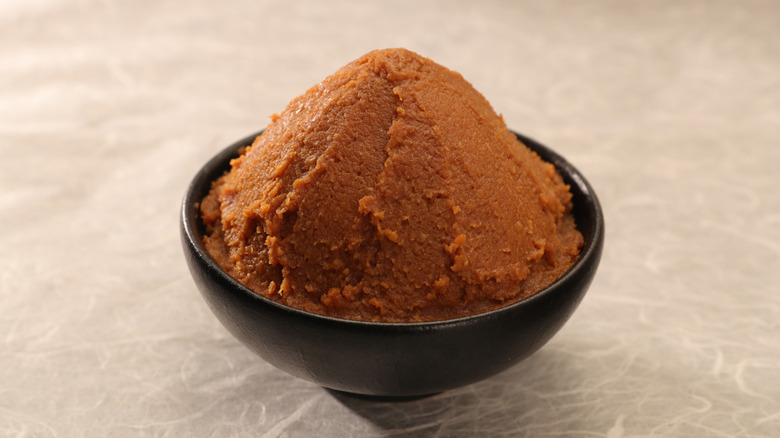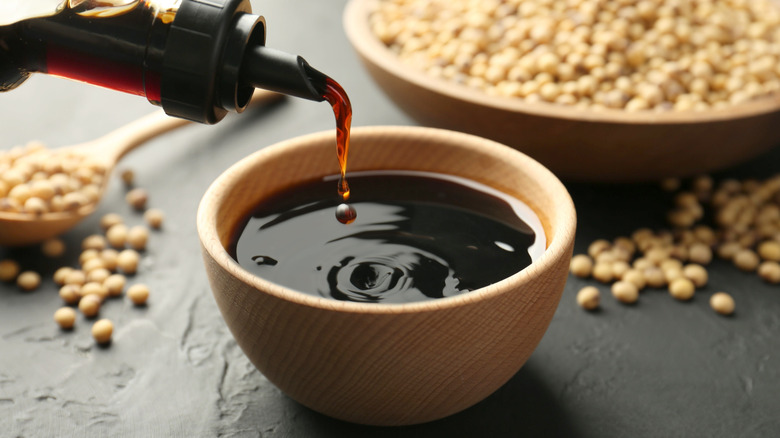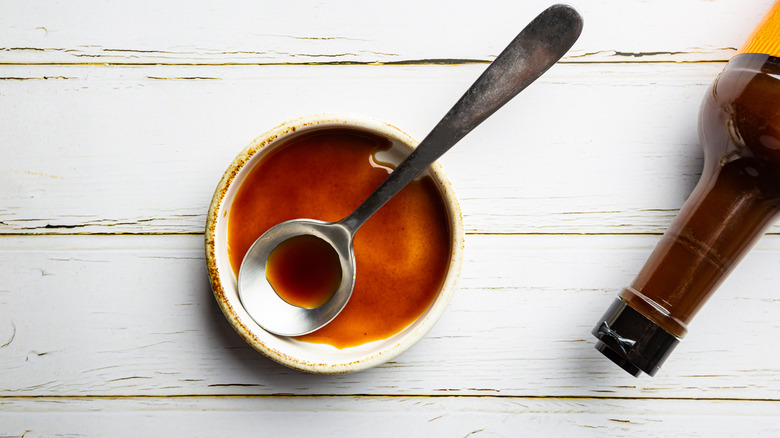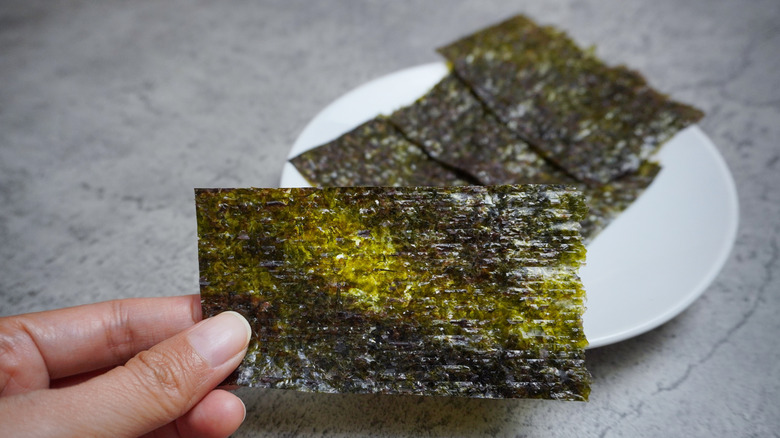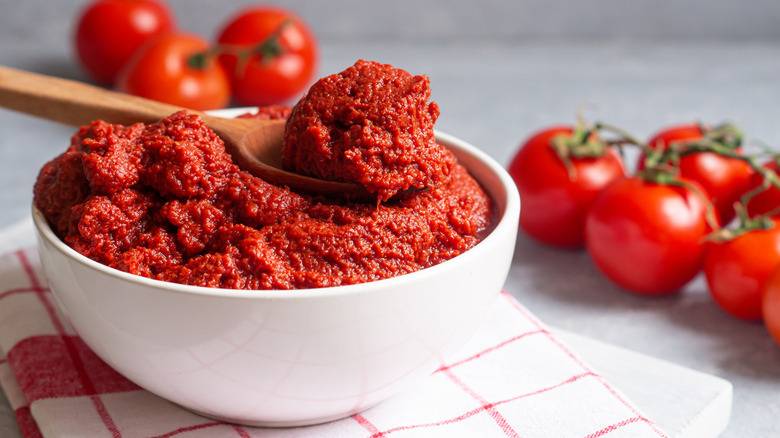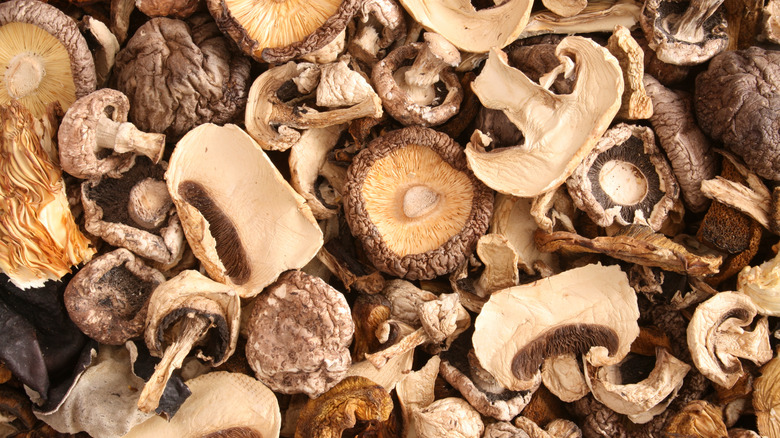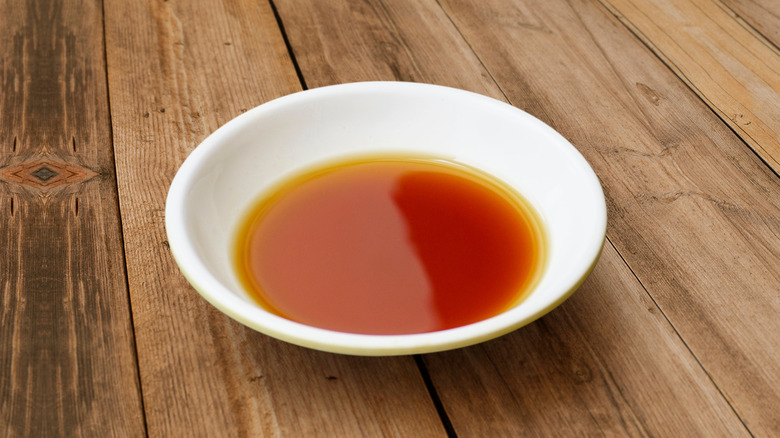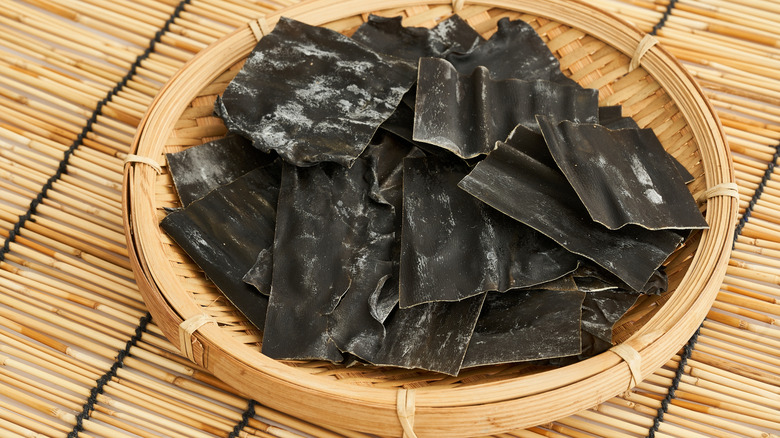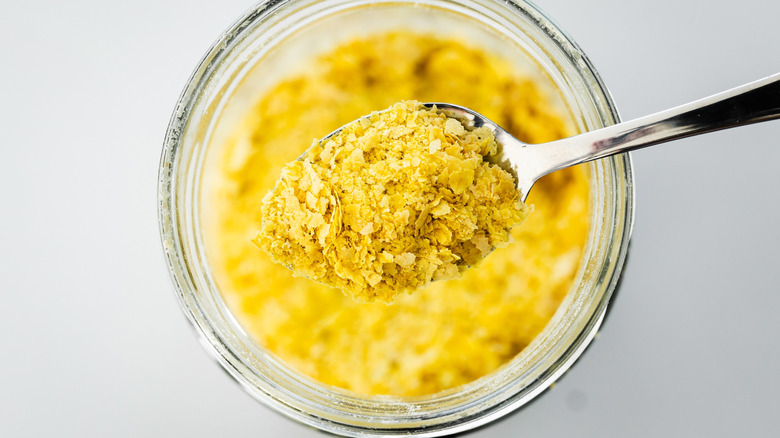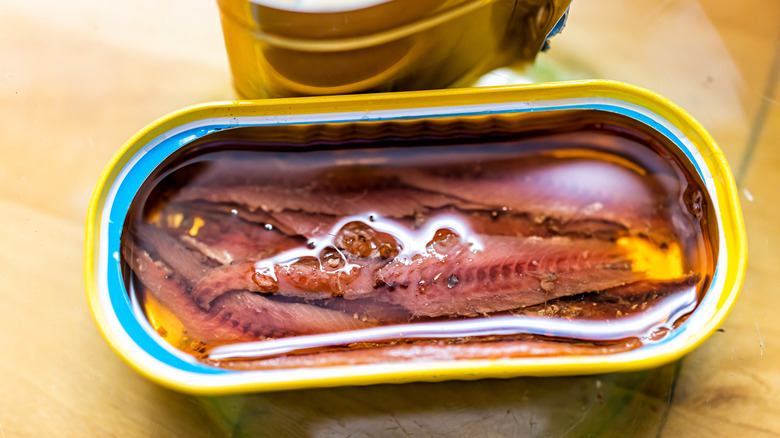The 13 Best Umami Boosting Ingredients You Should Always Have On Hand
Umami, which means "delicious savory taste" in Japanese, is the relatively new fifth taste, alongside sour, sweet, bitter, and salty. This flavor was identified by Kikunae Ikeda, a Japanese chemist, in the early 1900s. During this time, he was researching the sensation experienced after consuming dashi, the Japanese broth made from kombu (kelp) and bonito flakes. Through numerous laboratory studies, Ikeda succeeded in isolating the taste molecule glutamate, an amino acid found in kombu. In 1909, he argued the taste sensation triggered by glutamate should be added to the basic tastes that contribute to flavor.
A few years later, in 1913, a former student of Ikeda, Shintaro Kodama, joined his studies and identified inosinate, the compound in bonito flakes responsible for the umami flavor. Additionally, in 1957, Dr. Akira Kuninaka discovered sodium guanylate in dried shiitake mushrooms; thus, glutamate, guanylate, and inosinate were identified as the compounds that evoke the umami taste. Subsequent studies by chemists led to the international recognition of umami as the fifth basic taste, and in 2002, umami receptors were discovered on the tongue, validating its existence even more.
As a chef of 10 years, I am always searching for ingredients that exemplify the umami taste. Whether it's miso or anchovies, the key to getting umami flavor in your food is by stocking your pantry with ingredients containing the compounds that trigger the umami sensation. If you're having a hard time figuring out which umami-boost ingredients to buy, here are a few that I always have on hand.
Monosodium glutamate (MSG)
Monosodium glutamate (MSG) and umami go hand in hand. MSG is commonly used in savory foods as a flavor enhancer, and adding MSG to a dish is like sprinkling on a bit of umami flavor. It's a great addition to stir-fry recipes, homemade salad dressings, soups, egg dishes, or even as a garnish for some freshly popped popcorn. Similar to winemaking, MSG is made from fermented plant ingredients like sugarcane, corn, and other plants. The white powdery ingredient is naturally occurring in everyday foods such as aged cheeses, vegetables, meats, and seafood.
MSG was first discovered by Dr. Kikunae Ikeda who, while boiling down his wife's kelp broth, discovered that if he extracted the leftover crystallized compound, he could create glutamic acid (aka the main ingredient in MSG). After tasting the crystals, he isolated the umami flavor and patented it to produce the fifth taste in a physical form, thus creating MSG.
For years, MSG has been vilified for causing problems such as headaches, increased sweating, dizziness, and heart palpitations — however, that's the furthest thing from the truth. This long-standing myth has been associated with Chinese food since Robert Ho Man Kwok published a ludicrous hypothesis citing these symptoms were caused by MSG. His claims have since been debunked, and the addition of MSG in foods is "generally recognized as safe" by the FDA.
Aged cheese
Nothing complements a gorgeous plate of pasta like a heaping tower of freshly grated parmesan cheese. It gives whatever pasta you're enjoying, whether it be bolognese or carbonara, that extra boost of salty, savory flavor — and that's all thanks to unami. Aged cheeses, such as parmesan, pecorino, cheddar, or gouda, are great examples of umami-packed ingredients that you should always have on hand.
What makes these cheeses develop a quintessential salty, savory umami flavor is the long aging process called affinage, meaning "to refine" in French. This involves creating a curated environment in which the cheese can rest to develop its unique flavor and texture. Every type of aged cheese is stored at different temperature and humidity levels, involving specialized techniques like regular flipping and rotating to ensure the maturation of the cheese. The maturing process can continue for days, weeks, months, or even years depending on what characteristics you want to achieve.
Whether for filling up a charcuterie board, grating over a bowl of pasta, or garnishing a salad, aged cheeses always are an excellent way to add a bit of extra umami flavor.
Yuzu kosho
Are you looking for an umami-packed condiment to add to your refrigerator repertoire? Try yuzu kosho, the Japanese fermented citrus paste, and let the citrusy, spicy flavor dance across your tastebuds. Yuzu kosho is made from yuzu peel (a tart citrus common in East Asian cuisine), red or green chili peppers, and salt. The production process for yuzu kosho is fairly simple. It involves mashing together the chili peppers, yuzu, and salt, and letting the paste ferment for around a week, then you're left with the delicious citrusy paste.
This delectable condiment not only brings umami flavors to the table but also brings another level of brightness to whatever you're cooking. It's most common to use it as a garnish for things like grilled meats, fried foods, dumplings, and sashimi. Due to its bold aroma, yuzu kosho envelops itself perfectly in stocks and stew. In recent years, pastry chefs have also used Japanese condiments in more innovative ways, such as using it in sorbets, ice creams, custards, and other pastries.
You can find yuzu kosho either in a paste or powdered form at most Asian supermarkets; however, you can sometimes find it at Western grocery stores as well. This is definitely an ingredient you're going to want on hand to give your food an added punch of umami flavor.
Miso
If you're seeking a new way to enhance the flavor of your stocks and broths, consider replacing bouillon cubes and powdered broth mixes with miso, a deeply savory and fermented soybean paste. Miso is a quintessential ingredient in Japanese kitchens and is well-known for exemplifying the umami flavor. It is available in over 1,000 variations, but the two most common types are white or shiro miso, which has a mild, sweet taste, and red miso, which is fermented for a bit longer, giving it a red hue and deep salty flavor.
Miso is the primary flavoring agent for stocks, broths, and soups, such as miso soup in Japanese cuisine. Additionally, it serves as a marinade for meats and seafood, and it's one of the best glazes for flavorful salmon. Miso can also be used as a topping for grilled dishes like pork belly or chicken thighs, as its high salt content cuts through the rich fats in grilled meat perfectly. Few things compare to a blistering pork belly skewer crowned with a dollop of salty miso paste.
This umami ingredient is crafted from soybeans, salt, and koji, which consists of cooked rice and soybeans inoculated with a fermented Aspergillus oryzae culture. This culture is integral to many East Asian fermented products, including soy sauce, rice vinegar, and sake. For miso, koji is blended with cooked soybean mash to initiate fermentation. This process can last from a couple of months to several years, during which the koji ferments the soybeans, resulting in miso's rich umami flavor.
Soy sauce
Another staple umami ingredient you should always have at home is soy sauce. This salty, dark brown condiment is an important ingredient in Asian cooking. Add a splash to your marinade, stir-fry or sauce, or simply pour over white rice. Soy sauce is a byproduct of fermented soybeans and wheat. Similar to miso, koji is used during production; the fermented culture is added to steamed soybeans, roasted wheat, salt, and water. This mixture is referred to as "moromi" where it is left to naturally ferment for months to develop its flavor. After its fermentation period, the moromi is pressed and the raw soy sauce is extracted, which is then distilled to obtain its intense salty flavor.
Soy sauce has its roots in ancient China. At the time, it came in the form of a thick paste called "jiang," a mixture of meat and a millet fermenting agent. The mixture then went under the fermentation process with the liquid extract called "jiang you." Over time, the traditional method of soy sauce production evolved, with soybeans replacing the meat, resulting in the salty seasoning we know today!
There are thousands of soy sauces on the market, from light to dark to regional soy sauces like Vietnamese, Japanese, and Taiwanese — all of them with different purposes, whether it's for cooking, dipping, or marinating. When trying to find the right soy sauce for your pantry, consider your taste preference and decide if you're craving an extra-salty flavor or a type with a more mild, balanced flavor.
Worcestershire sauce
When we think about umami, some ingredients that instantly come to mind are parmesan, tomatoes, and soy sauce. However, there's one ingredient that's probably collecting dust in your refrigerator that you wouldn't even think of — Worcestershire sauce. Don't let the tongue twister name throw you off, as Worcestershire sauce is a delicious condiment that's excellent for adding a bit of umami tang to salad dressings, steaks, hamburgers, or other cooked meat dishes.
Worcestershire sauce is a vinegar-based fermented sauce often flavored with anchovies, sugar, onion, sugar, garlic, soy sauce, lemon, and tamarind — each one is flavored a bit differently depending on the brand. The sauce originates from the city of Worcester, England where pharmacists John Wheeley Lea and William Henry Perrins invented it in the 19th century. As legend has it, a British soldier brought the recipe back from India, and he commissioned Lea and Perrins to craft up the sauce. They later forgot the sample in their cellar, where it fermented and created the delicious sauce we now enjoy today! Although the story is just a legend, Worcestershire sauce has become a popular condiment used around the globe.
Seaweed
Nori is a dried edible seaweed that's well-known for its distinct salty, sweet flavor with an undeniably strong umami taste. It's mostly used to wrap sushi rolls or onigiri (rice balls), but it can be used for so much more! You can sprinkle it over a bowl of rice, turn it into a garnish for salads, or use it as a component in soups and stews. Pro tip: You can also grind up some nori sheets to create the ultimate umami powder that's excellent for sprinkling over a bowl of popcorn or even a slice of pizza.
You might be thinking nori is made from the seaweed that has washed up on the shores of beaches. However, nori is actually made from a species of red algae called Porphyra and is traditionally enjoyed across Asia and even Wales. The production of nori starts in the intertidal zone of the ocean, typically off the coast of Japan in the Ariake Sea or off the coast of Kyushu island. The plant is then grown and harvested from autumn to spring. After collection, the nori is cleaned, shredded, pulverized, and pressed into sheets. Lastly, it's dried and then roasted to obtain its quintessential savory flavor and crispy texture.
Tomato paste
If you want another way to level up your weeknight pasta with loads of umami flavor, you should try adding a squirt of tomato paste. This thick, concentrated paste is made by slow-cooking tomatoes until almost all of their water has evaporated, then its seeds and skin are discarded, and the mixture is blitzed, resulting in a tasty, smooth, bright red paste. Since tomatoes have a high content of glutamic acid, the naturally occurring amino acid that triggers the umami taste, when it's concentrated in a paste, it shines through to its fullest potential of flavor.
Tomato paste can be used as a flavor enhancer in a multitude of dishes or it can be used as a thickening agent for sauces, stews, and other braised meat dishes. Whether you buy canned or tubed tomato paste, it's a great way to add umami flavor to your dishes and should definitely be added to your list of essential pantry ingredients.
Dried mushrooms
Other than their whimsical appearance, one of the most distinctive characteristics of mushrooms is their umami flavor — and when they're dried, it's even more profound. Mushrooms are high in glutamic acid, so the dehydration process concentrates the naturally occurring amino acid, resulting in an extremely savory flavor. There are tons of ways to use dried mushrooms in your everyday cooking routine, the key is to rehydrate them to harness their fullest potential. Think of it as a flavor bomb you can drop into stock, broths, stews, and soups, just like what you would do with herbs: Put a few dried mushrooms in a sachet, drop it in, and let them do their magic. You can also make a mushroom broth and incorporate it into a risotto or a tomato sauce. If you want to go the extra mile, pulse them up and create an umami-packed compound butter.
The most commonly sold dried mushrooms are porcini, shiitake, oyster, chanterelle, and morel. Among all these mushrooms, shiitake is known for having the most concentrated umami flavor. Dried and rehydrated shiitake mushrooms produce glutamate and guanylate, which heighten the umami flavor in whatever dish you incorporate it into.
Fish sauce
Another umami-boosting ingredient you might not already own is fish sauce. This pungent, savory fermented condiment is often used in Southeast Asian cuisine, particularly in Thai, Vietnamese, Indonesian, and Filipino dishes, and it's a great way to give your dish a boost of rich umami flavor. It's most common to use fish sauce as a seasoning while cooking or as dipping sauce. Anytime you're cooking a Southeast Asian dish like pad Thai, pho, or tom yum, you're most likely going to end up adding a splash or two of fish sauce. What's more, there are numerous delicious ways you can use fish sauce at home, including creating a delicious sauce for roasted vegetables or even spiking your favorite cocktails for a bit of a savory, umami boost.
Fish sauce is made by fermenting small species of fish like anchovies and adding salt. The mixture is typically left in ceramic jars in a warm environment to ferment anywhere from three months to a year, in which the salt breaks down the proteins and enzymes in the fish. During this time, the jars are often left uncovered in direct sunlight to ensure each batch obtains the quintessential aroma and clear, light brown color. After the fermentation is finished, the mixture is then filtered, pressed, rested once more to get rid of any residual odor, then bottled.
Kombu
Often described as the cornerstone of Japanese cuisine, kombu, also called kelp, dashima, or haidai, is thick flat seaweed that's harvested from brown algae. Kombu is commonly used to flavor stock, broth, and soups. It's usually sold in very large, dried sheets, but in most Asian supermarkets you can find it in a powdered form or inside a sachet that's ready to be boiled. The kelp is extremely high in glutamic acid, so in Japanese kitchens, it's typically steeped in hot water to extract its umami-packed flavor to create the stock, dashi, which is the backbone of many dishes.
Dashi is made from kombu, bonito flakes, and occasionally dried shiitake mushrooms, and all three of these ingredients are the compounds that trigger the umami reaction, thus making dashi an absolute flavor explosion. Besides making dashi, there are a multitude of ways you can use kombu in your everyday cooking. You can simply add a pot of simmering rice, use the sheets for steaming seafood, or make kombu tsukudani, a savory Japanese seaweed salad that pairs flawlessly with a bowl of rice.
Nutritional yeast
Not only is nutritional yeast a vegan staple you need in your kitchen, but it's also an umami-boosting ingredient you should definitely keep stocked in your pantry. For those of you who don't know, nutritional yeast (aka "nooch") is basically deactivated yeast in a powdered form. It's similar to the yeast used in bakeries and beer making, but it's been heat-treated, so it's unable to ferment. Since nutritional yeast is free from any soy, dairy, nuts, and gluten, it's often used as a nutrient replacement in plant-based diets.
Nutritional yeast contains high levels of glutamic acid, so it's known to add a great deal of umami flavor to whatever you're eating. People commonly sprinkle it onto roasted vegetables, stews, or salads. It's also a great vegetarian substitute for parmesan cheese. It's especially delicious as a garnish for pasta or popcorn. So, ditch the butter and salt, grab a bottle of nutritional yeast, and add some umami flavor to your food.
Anchovies
Often described as an "umami bomb," anchovies are tiny saltwater fish that are an excellent example of tasty umami flavor. These fish have an extremely salty and briny flavor, but they don't really taste like fish at all. Since anchovies in dishes are known to dissolve into the sauce, they typically only leave behind its salty umami flavor rather than a fishy taste and aroma.
Typically, you can find anchovies dried and packed in salt, water, or oil, but they also come in a paste form. If you buy the oil-packed type, don't discard your leftover oil, as there are numerous ways you can use that flavorful leftover oil from canned anchovies, including drizzling it over pizza or using it to rub a roast chicken. These small but mighty fish can be used in loads of creative ways in the kitchen, whether it be adding to salad dressing or tossing it in your pasta sauce, so you should always make sure you've got anchovies on hand in case you need an extra lift of umami flavor.

